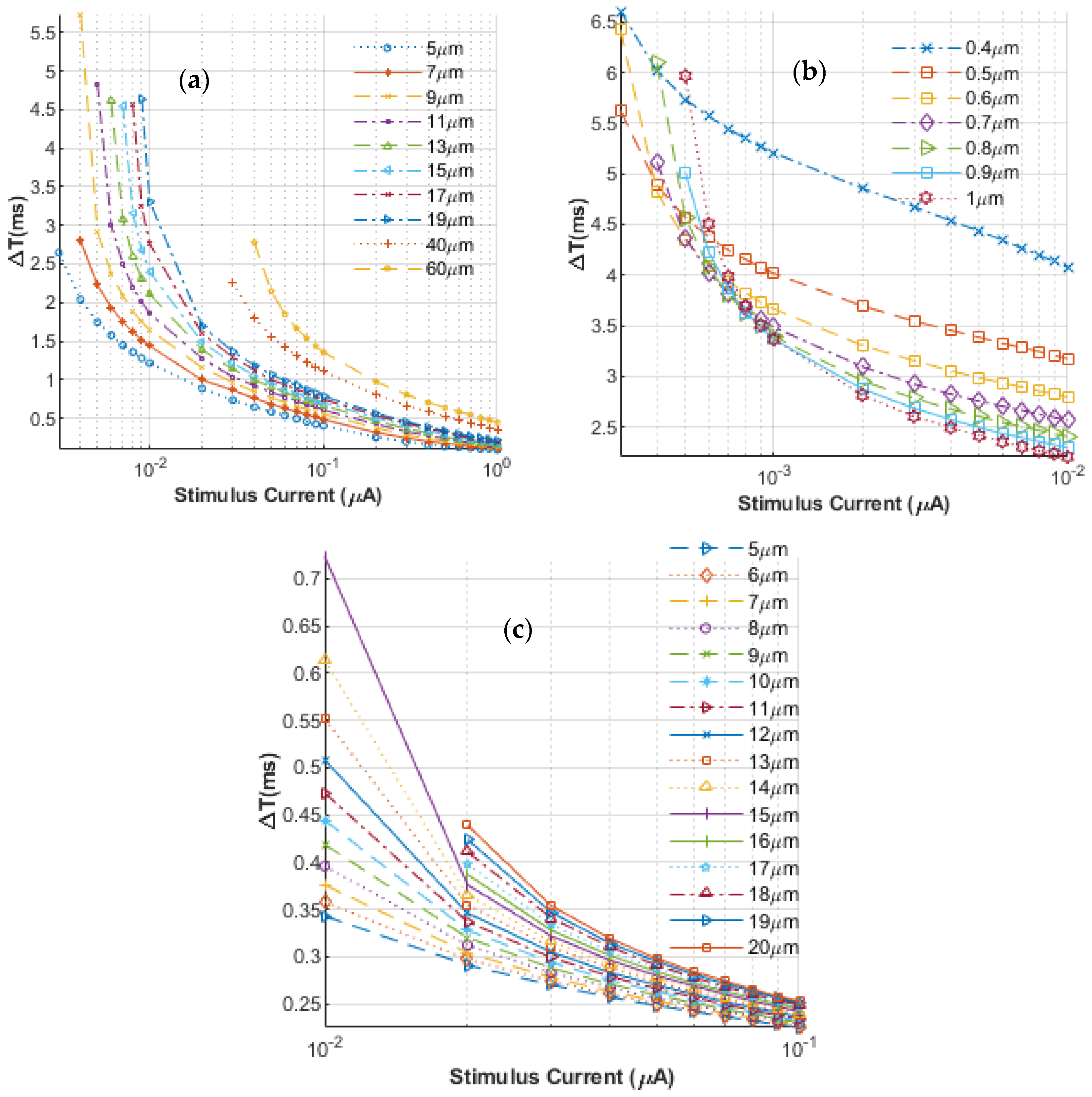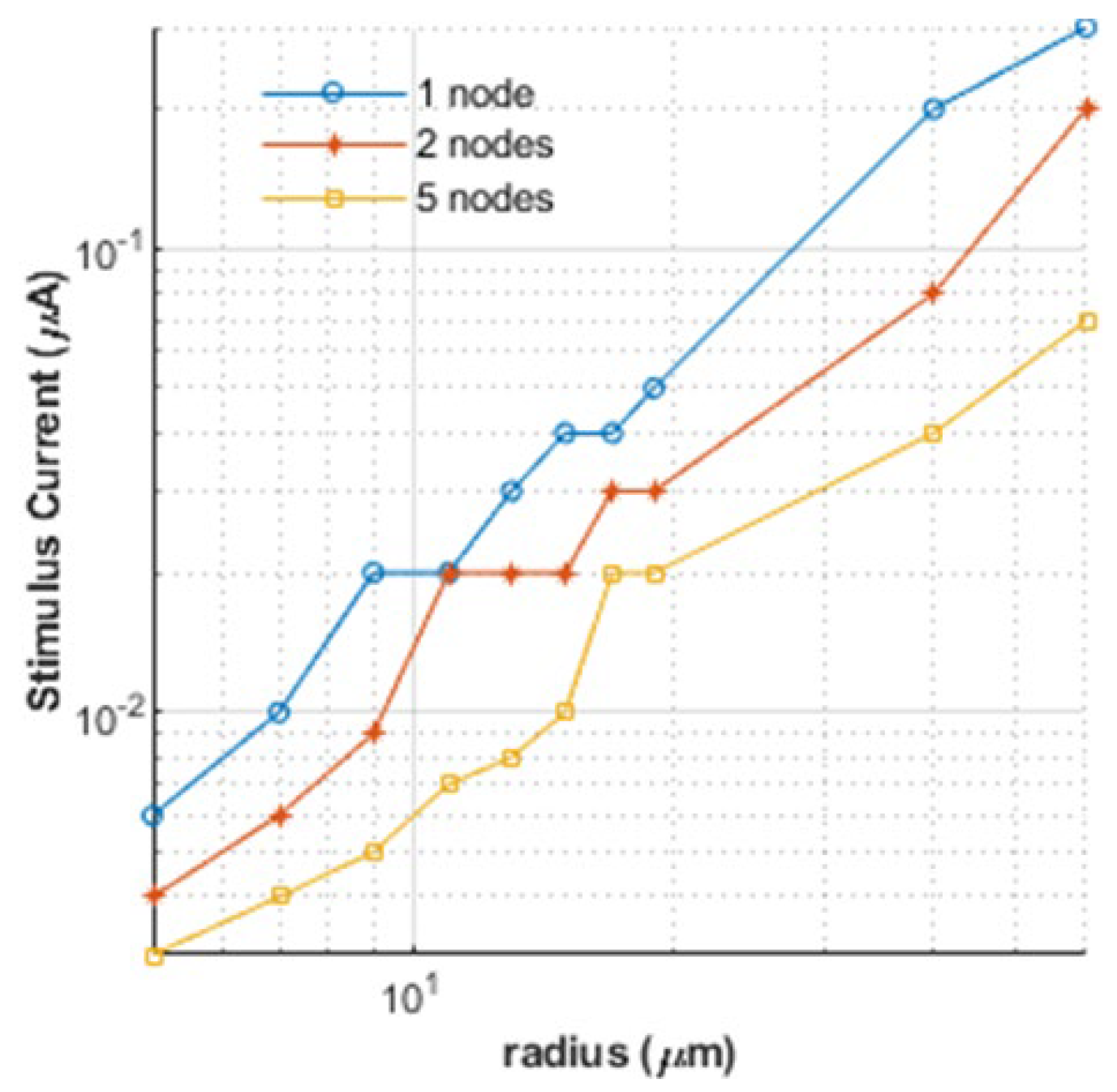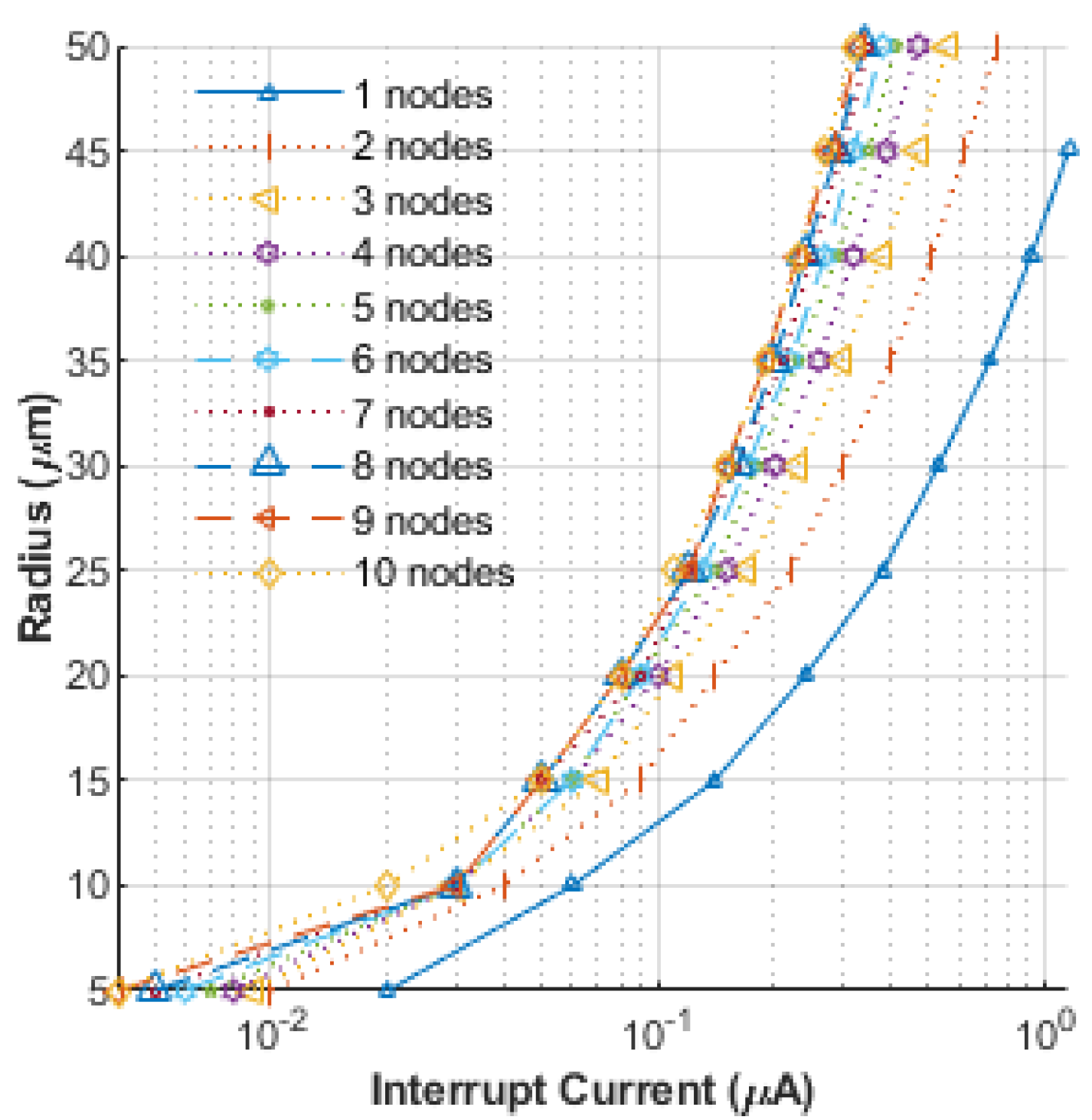Assessing Thresholds for Nerve Activation and Action Potential Block Using a Multielectrode Array to Minimize External Stimulation
Abstract
1. Introduction
2. Materials and Methods
3. Results and Discussion
4. Conclusions
Author Contributions
Funding
Institutional Review Board Statement
Informed Consent Statement
Data Availability Statement
Conflicts of Interest
References
- Waters, R.L.; McNeal, D.R.; Faloon, W.; Clifford, B. Functional electrical stimulation of the peroneal nerve for hemiplegia. Long-term clinical follow-up. J. Bone Jt. Surg. Am. 1985, 67, 792–793. [Google Scholar] [CrossRef]
- Tanagho, E.A.; Schmidt, R.A.; Orvis, B.R. Neural stimulation for control of voiding dysfunction: A preliminary report in 22 patients with serious neuropathic voiding disorders. J. Urol. 1989, 142, 340–345. [Google Scholar] [CrossRef] [PubMed]
- Baker, L.L.; McNeal, D.R.; Benton, L.A.; Bowman, B.R.; Waters, R.L. Neuromuscular Electrical Stimulation: A Practical Guide; Los Amigo Research Education Institute: Downey, CA, USA, 1993. [Google Scholar]
- Stein, R.B.; Chong, S.L.; James, K.B.; Kido, A.; Bell, G.J.; Tubman, L.A.; Belanger, M. Electrical stimulation for therapy and mobility after spinal cord injury. Prog. Brain Res. 2002, 137, 27–34. [Google Scholar]
- Popovic, M.R.; Thrasher, T.A. Neuroprostheses. In Encyclopedia of Biomaterials and Biomedical Engineering; Wnek, G.E., Bowlin, G.L., Eds.; Marcel Dekker Press: New York, NY, USA, 2004; Volume 2, pp. 1056–1065. [Google Scholar]
- Tsai, S.J.; Lew, H.L.; Date, E.; Bih, L.I. Treatment of detrusorsphincter dyssynergia by pudendal nerve block in patients with spinal cord injury. Arch. Phys. Med. Rehabil. 2002, 83, 714–717. [Google Scholar]
- Baratta, R.; Ichie, M.; Hwang, S.K.; Solomonow, M. Orderly stimulation of skeletal muscle motor units with tripolar nerve cuff electrode. IEEE Trans. Biomed. Eng. 1989, 36, 836–843. [Google Scholar] [CrossRef]
- Fang, Z.P.; Mortimer, J.T. A method to effect physiological recruitment order in electrically activated muscle. IEEE Trans. Biomed. Eng. 1991, 38, 175–179. [Google Scholar] [CrossRef]
- Cattell, M.; Gerard, R.W. The inhibitory effect of high-frequency stimulation and the excitation state of nerve. J. Physiol. 1935, 83, 407–415. [Google Scholar] [CrossRef]
- Whitwam, J.G.; Kidd, C. The use of direct current to cause selective block of large fibers in peripheral nerves. Br. J. Anaesth. 1975, 47, 1123–1133. [Google Scholar] [CrossRef]
- Bhadra, N.; Kilgore, K. Direct current electrical conduction block of peripheral nerve. IEEE Trans. Neural Syst. Rehab. Eng. 2004, 12, 313–324. [Google Scholar]
- Tai, C.; de Groat, W.C.; Roppolo, J.R. Simulation analysis of conduction block in unmyelinated axons induced by high-frequency biphasic electrical currents. IEEE Trans. Biomed. Eng. 2005, 52, 1323–1332. [Google Scholar]
- Joshi, R.P.; Mishra, A.; Song, J.; Pakhomov, A.; Schoenbach, K.H. Simulation studies of ultra-short, high-intensity electric pulse induced action potential block in whole-animal nerves. IEEE Trans. Biomed. Eng. 2008, 55, 1391–1398. [Google Scholar] [PubMed]
- Joshi, R.P.; Mishra, A.; Song, J.; Hu, Q.; Schoenbach, K.H.; Pakhomov, A. Self-consistent analyses for potential conduction block in nerves by an ultra-short, high-intensity electric pulse. Phys. Rev. E 2007, 75, 061906. [Google Scholar]
- Tracey, K.J. The revolutionary future of bioelectronic medicine. Bioelectron. Med. 2014, 1, 1–15. [Google Scholar]
- Birmingham, K.; Gradinaru, V.; Anikeeva, P.; Grill, W.M.; Pikov, V.; McLaughlin, B.; Pasricha, P.; Weber, D.; Ludwig, K.; Famm, K. Bioelectronic medicines: A research roadmap. Nat. Rev. Drug Discov. 2014, 13, 399–400. [Google Scholar]
- Pavlov, V.A.; Tracey, K.J. Bioelectronic medicine: Updates, challenges and paths forward. Bioelectron. Med. 2019, 5, 1–4. [Google Scholar]
- Grayden, D.B.; Clark, G.M. Implant design and development. In Cochlear Implants: A Practical Guide; Cooper, H., Craddock, L., Eds.; Whurr: London, UK, 2006; pp. 1–20. [Google Scholar]
- Lewis, P.M.; Ackland, H.M.; Lowery, A.J.; Rosenfeld, J.V. Restoration of vision in blind individuals using bionic devices: A review with a focus on cortical visual prostheses. Brain Res. 2015, 1595, 51–73. [Google Scholar]
- Van De Berg, R.; Guinand, N.; Nguyen, T.K.; Ranieri, M.; Cavuscens, S.; Guyot, J.P.; Stokroos, R.; Kingma, H.; Perez-Fornos, A. The vestibular implant: Frequency-dependency of the electrically evoked vestibulo-ocular reflex in humans. Front. Syst. Neurosci. 2015, 8, 255. [Google Scholar]
- Papageorgiou, P.N.; Deschner, J.; Papageorgiou, S.N. Effectiveness and adverse effects of deep brain stimulation: Umbrella review of meta-analyses. J. Neurol. Surg. A Cent. Eur. Neurosurg. 2017, 78, 180–190. [Google Scholar]
- Greenberg, B.D.; Malone, D.A.; Friehs, G.M.; Rezai, A.R.; Kubu, C.S.; Malloy, P.F.; Salloway, S.P.; Okun, M.S.; Goodman, W.K.; Rasmussen, S.A. Three-year outcomes in deep brain stimulation for highly resistant obsessive-com-pulsive disorder. Neuropsychopharmacology 2006, 31, 2384–2393. [Google Scholar]
- Nagaraj, V.; Lee, S.T.; Krook-Magnuson, E.; Soltesz, I.; Benquet, P.; Irazoqui, P.P.; Netoff, T.I. Future of seizure prediction and intervention: Closing the loop. J. Clin. Neurophysiol. 2015, 32, 194–206. [Google Scholar]
- Schlaepfer, T.E.; Cohen, M.X.; Frick, C.; Kosel, M.; Brodesser, D.; Axmacher, N.; Joe, A.Y.; Kreft, M.; Lenartz, D.; Sturm, V. Deep brain stimulation to reward circuitry alleviates anhedonia in refractory major depression. Neuropsychopharmacology 2008, 33, 368–377. [Google Scholar] [CrossRef] [PubMed]
- Gordon, T.; English, A.W. Strategies to promote peripheral nerve regeneration: Electrical stimulation and/or exercise. Eur. J. Neurosci. 2016, 43, 336–350. [Google Scholar] [CrossRef]
- Hodgkin, A.L.; Huxley, A.F. A quantitative description of membrane current and its application to conduction and excitation in nerve. J. Physiol. 1952, 117, 500–544. [Google Scholar] [CrossRef] [PubMed]
- Tarnaud, T.; Joseph, W.; Martens, L.; Tanghe, E. Dependence of excitability indices on membrane channel dynamics, myelin impedance, electrode location and stimulus waveforms in myelinated and unmyelinated fibre models. Med. Biol. Eng. Comput. 2018, 56, 1595–1613. [Google Scholar] [PubMed]
- Hill, T.L.; Chen, Y.D. On the theory of ion transport across the nerve membrane: Noise from the open-close kinetics of K+ channels. Biophys. J. 1972, 12, 948–959. [Google Scholar] [CrossRef]
- Skaugen, E.; Walløe, L. Firing behaviour in a stochastic nerve membrane model based upon the Hodgkin-Huxley equations. Acta Physiol. Scand. 1979, 107, 343–363. [Google Scholar]
- Strassberg, A.F.; DeFelice, L.J. Limitations of the Hodgkin-Huxley formalism: Effects of single channel kinetics on transmembrane voltage dynamics. Neural Comput. 1993, 5, 843–855. [Google Scholar] [CrossRef]
- White, J.A.; Rubinstein, J.T.; Kay, A.R. Channel noise in neurons. Trends Neurosci. 2000, 23, 131–137. [Google Scholar]
- Sokol, M.; Baker, C.; Baker, M.; Joshi, R.P. Simple model to incorporate statistical noise based on a modified Hodgkin-Huxley approach for external electrical field driven neural responses. Biomed. Phys. Eng. Express 2024, 10, 045037. [Google Scholar] [CrossRef]
- Cooley, J.W.; Dodge, F.A., Jr. Digital computer solutions for excitation and propagation of the nerve impulse. Biophys. J. 1966, 6, 583–599. [Google Scholar] [CrossRef]
- McNeal, D.R. Analysis of a model for excitation of myelinated nerve. IEEE Trans. Biomed. Eng. 1976, 23, 329–337. [Google Scholar] [CrossRef] [PubMed]
- Rattay, F. Analysis of models for external stimulation of axons. IEEE Trans. Biomed. Eng. 1986, 33, 974–977. [Google Scholar]
- Rattay, F. Electrical Nerve Stimulation: Theory, Experiments and Applications; Springer: New York, NY, USA, 1990. [Google Scholar]
- Reilly, J.P. Electrical Stimulation and Electropathology; Cambridge Press: Cambridge, UK, 1982. [Google Scholar]
- Mascagni, M. The backward Euler method for numerical solution of the Hodgkin-Huxley equations of nerve conduction. Siam J. Numer. Anal. 1990, 27, 941–962. [Google Scholar] [CrossRef]
- Benzi, R.; Sutera, A.; Vulpiani, A. The mechanism of stochastic resonance. J. Phys. A Math. Gen. 1981, 14, L453–L457. [Google Scholar]
- Rowat, P. Interspike interval statistics in the stochastic Hodgkin-Huxley model: Coexistence of gamma frequency bursts and highly irregular firing. Neural Comput. 2007, 19, 1215–1250. [Google Scholar] [CrossRef] [PubMed]
- Schmid, G.; Goychuk, I.; Hanggi, P. Effect of channel block on the spiking activity of excitable membranes in a stochastic Hodgkin-Huxley model. Phys. Bio. 2004, 1, 61–66. [Google Scholar] [CrossRef]
- Matias, I.; Maturana, M.I.; Apollo, N.V.; Hadjinicolaou, A.E.; Garrett, D.J.; Cloherty, S.L.; Kameneva, T.; Grayden, D.B.; Ibbotson, M.R.; Meffin, H. A simple and accurate model to predict responses to multi-electrode stimulation in the retina. PLoS Comput. Biol. 2016, 12, e1004849. [Google Scholar]
- Rozman, J.; Pečlin, P.; Ribarič, S.; Godec, M.; Burja, J. An improved method of crafting a multi-electrode spiral cuff for the selective stimulation of peripheral nerves. Sci. Rep. 2018, 8, 915. [Google Scholar]
- Liu, F.; Habibollahi, M.; Wu, Y.; Neshatvar, N.; Zhang, J.; Zinno, C.; Akouissi, O.; Bernini, F.; Alibrandi, L.; Gabisonia, K.; et al. A multi-channel stimulator with an active electrode array implant for vagal-cardiac neuromodulation studies. Bioelectron. Med. 2024, 10, 16. [Google Scholar] [CrossRef]







Disclaimer/Publisher’s Note: The statements, opinions and data contained in all publications are solely those of the individual author(s) and contributor(s) and not of MDPI and/or the editor(s). MDPI and/or the editor(s) disclaim responsibility for any injury to people or property resulting from any ideas, methods, instructions or products referred to in the content. |
© 2025 by the authors. Licensee MDPI, Basel, Switzerland. This article is an open access article distributed under the terms and conditions of the Creative Commons Attribution (CC BY) license (https://creativecommons.org/licenses/by/4.0/).
Share and Cite
Mishra, A.; Joshi, R.P. Assessing Thresholds for Nerve Activation and Action Potential Block Using a Multielectrode Array to Minimize External Stimulation. Bioengineering 2025, 12, 372. https://doi.org/10.3390/bioengineering12040372
Mishra A, Joshi RP. Assessing Thresholds for Nerve Activation and Action Potential Block Using a Multielectrode Array to Minimize External Stimulation. Bioengineering. 2025; 12(4):372. https://doi.org/10.3390/bioengineering12040372
Chicago/Turabian StyleMishra, Ashutosh, and R. P. Joshi. 2025. "Assessing Thresholds for Nerve Activation and Action Potential Block Using a Multielectrode Array to Minimize External Stimulation" Bioengineering 12, no. 4: 372. https://doi.org/10.3390/bioengineering12040372
APA StyleMishra, A., & Joshi, R. P. (2025). Assessing Thresholds for Nerve Activation and Action Potential Block Using a Multielectrode Array to Minimize External Stimulation. Bioengineering, 12(4), 372. https://doi.org/10.3390/bioengineering12040372







